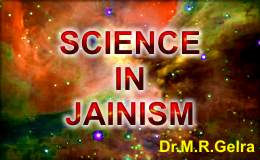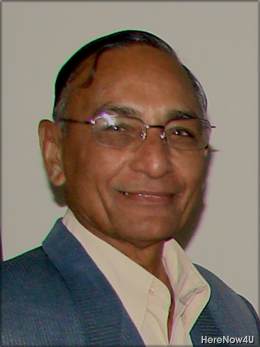
Jain monastic learning and scholarship originated and developed from the need of transmitting and handing down to pupils the explanations of the sacred scriptures of Jainism. The teachings of Mahavira were first transmitted orally from one generation to another and later on they were reduced to writing in the Prakrit language in an archaic style, which was popular two thousand years ago. Jain Acharyas with a view to providing a scientific justification to the old inherited literature, gave special emphasis on methodology and in doing so established a distinctive trait of Jain Scholasticism. They evolved quite a number of different systems of interpretative tools to explain the legitimacy of the traditions as mentioned in the canonical texts. Philosophically, the most scientific and efficacious part of the methodology is the theory of non-absolutism i.e. Anekantvad.
During the formative period of Anekantvad there were two prominent rival schools of thought in India. The Vedanta school posited reality i.e. the substance or dravya alone as the ultimate truth whereas the Buddhist phenomenalism accepted the modes of substance as the ultimate truth. The Jains appropriated them both and accepted, according to Jain Logic (Anekant) both substance and the various modes as the ultimate truth. This is how the doctrine of Anekant became the central thesis of Jain Philosophical thinking.
Anekantvad simply means viewing the Reality or Truth in its diverse aspects. It promotes a many sided approach to the problem of the knowledge of Reality. Each object of knowledge is found to be endowed with infinite attributes. Some of them appear to be mutually contradictory but they do coexist in the same object. This is the intrinsic nature of Reality. So the knowledge of the true nature of every object should be viewed from different angles. Thinkers having a singular view in mind can see only one facet of Reality and cannot realise Reality in full.
Hermann Jacobi, the German Indologist has pointed out that Anekant opens the floodgates to the comprehension of Reality not only in toto but also in its different aspects. The principle of Anekant has been successfully applied to the mutual relationship between the body and soul. The Jains believe that substance is permanent but its modes are changeable. The soul is permanent but its mode, the body of a living being is changeable. The Jains again mention a dialogue which took place between Lord Mahavira and his first disciple Gautama. It was initiated at follows:
Gautama:
"Is the soul permanent or impermanent, O Lord?"
Lord:
"The soul is permanent in some respect and impermanent in another respect.
It is permanent in respect of its substance, which is eternal and it is impermanent in respect of the modes, which originate and vanish."
Tattvaarth Sutra of Umaswati provides the definition of the Reality as follows:
‘Utpaad-Vyaya-dhrauvya-yuktem-Sat’ i.e. origination, cessation and continuity exist in 'Sat' i.e. Reality. The Jains describe substance as eternal but its modes as changeable. The examples are as follows:
- An earthern pot exists at one time as permanent as long as it is unbroken but when it breaks into pieces it becomes transitory. However, the sand or the clay of which the pot is made remains imperishable.
- Gold ornaments can be changed from one form to another but the basic material gold does not perish.
Similarly man is immortal in relation to his soul but mortal in relation to the body. The conditioned mode of the existence of a substance and its attributes, at a particular time has been termed 'paryaya'. The concept of paryaya is foundational to Jain view of Reality and the most significant and singular contribution of the Jain school in the field of metaphysics is the distinction between dravya and guna of the substance. There are infinite ways or modes in which reals can exist and this idea paves the way for the advocacy of Anekantavad.
Anekant unfolds its vision through Syadvad. There is an important relation between Anekantvad and Syadvad and they are closely interrelated. Anekant relates with the relative nature of infinite knowledge, Syadvad relates to its verbal expression; which is always finite. Historically, it is assumed that Syadvad or the system of Saptabhangi is a later development in Jainism, and the doctrine of Anekantvad, the first and the most fundamental teaching of Mahavira, seems to precede Syadvad.
Syadvad is the synthetic method of knowledge and insists on making the statements conditionally keeping in mind a certain context. Since all human knowledge is relative, the judgemental and linguistic expression of it has also to contain the relations and conditions, which characterize such knowledge. This is the theory of Syadvad, which has been further formalized in the form of Saptabhangi. The seven fold expressions are; Syad-asti, Syad-nasti, Syad-asti-nasti, Syad-avaktavya, Syad-asti-avaktavya, Syad-nastiavaktavya, Syad-asti-nasti-avaktavya. (Asti means affirmation, nasti means negation, avaktavya means indescribable).
Looking to the criticism of the word 'Syat' in Syadvad or Saptabhangi in certain corners, Acharya Mahapragya has emphasized the use of the term 'eva' in the seven usual propositions (saptabhangi) for the popular example of pot which indicates the definite character of the assertion, or the negation or indescribability or their possible combinations. He further stresses the use of 'Syat' for the rest of the attributes other than existence in the pot. Acharya Mahapragya has certainly given a new dimension in Jain logic to prevent any controversy regarding the doctrine of Anekantvad.
We find that the concept of anekantvad, syadvad and saptabhangi are intimately related to each other and provide the foundation of Jain metaphysics, epistemology and logic respectively.
Anekant is supported by the independent system of Nayavada, seven possible modes of approach and description, one of which is singled out without regard to the others according to the need and purpose of the case. It implies that the real may be explained and examined from divergent viewpoints. These divergent viewpoints present a comprehensive and synoptic picture of Reality. It is an analytical method. The Jains narrate a story about seven blind men and the elephant. All the blind men surrounded the elephant and touched its body. Somebody got the ear of the elephant, and others got the trunk or the tail or some other part of the body. The person who caught the leg of the elephant said that that elephant was like a pillar and he who caught the trunk said that the elephant was like a python and in this way every blind man asserted that his description alone was correct. The Jains say 'Only who can see the whole elephant can say the truth'.
 Dr. Mahavir Raj Gelra
Dr. Mahavir Raj Gelra

